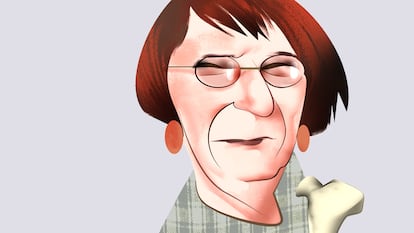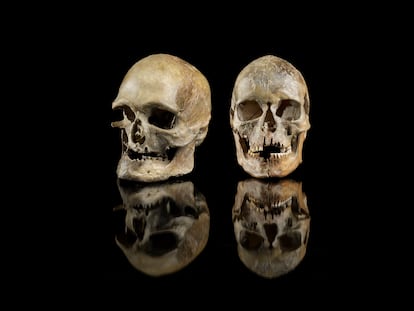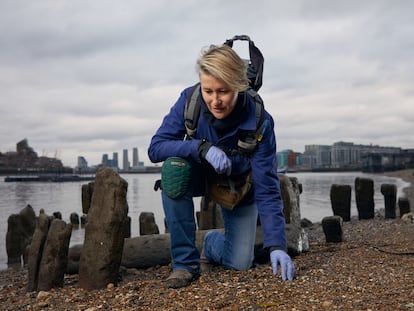Madelaine Böhme, the paleontologist who challenged long-held tenets about the cradle of humanity
The German scientist’s research on the European hominid sparked controversy by theorizing that the human race may not have originated in Africa

If Charles Darwin were alive, he’d be pulling his hair out over German paleontologist Madelaine Böhme’s controversial theories. Böhme is challenging two centuries of scientific orthodoxy that identifies Africa as the cradle of humanity. Instead, she points to Europe, a continent that resembled the African savannah millions of years ago. Her story is populated with hitherto unknown apes that could walk on two legs and a fascinating Indiana Jones-style tale complete with Nazis and a hidden treasure.
The prevailing scientific theory is that the great apes and humans diverged seven million years ago in Africa. Our closest relative is the chimpanzee, with which we share 99% of our genes. No one knows exactly how this transition happened or how bipedalism evolved, whether from orangutans hanging from trees or gorillas resting on their knuckles. Böhme believes she has found one of the missing pieces of the human evolution puzzle — a missing link.
The crucial clue to solving the mystery came from a Nazi: geologist Bruno von Freyberg. While building bunkers around Athens during World War II, he found a jawbone that looked like it belonged to an ape. Years later, a study conducted in the 1970s determined that the jawbone belonged to a new hominid — Graecopithecus.
In 2009, Böhme was busy studying the evolution of the environment and fauna, unaware that life had a big surprise in store when she found a molar of a great ape in Azmaka, Bulgaria. She had heard the story of Von Freyberg as a young girl and suddenly found herself thrust into the puzzle she had always dreamed of solving.
Böhme’s interest in paleontology began as a child when someone gave her a sea stone. She was six when she participated in her first excavation and 12 when she organized her own exploration. At 19, she found a fossil of a prehistoric elephant. Böhme was born to a Bulgarian mother and German father in Plovdiv, Bulgaria’s second-largest city and the oldest uninterrupted human settlement in Europe, more than six millennia old. Wandering around Plovdiv is like standing on a giant Napoleon pastry with thousands of enigmatic layers.
“Madelaine is one of those rare researchers with the determination and courage to pursue the unpopular theory that human lineage originates in Europe. Some people have unusual ideas but are never able to substantiate them. But Madelaine found her evidence in primate fossils and the sediment that covered them,” said Swedish paleontologist Per Ahlberg. A professor at Uppsala University (Sweden), Alhberg is collaborating with Böhme in a study of the origin of a fossilized footprint on a beach in Crete (Greece). The human-like footprint is six million years old, predating almost all African fossils.
Böhme, a professor at the University of Tübingen (Germany), has just completed a paper for Nature describing a new species of great ape in Europe. She does not believe that our ancestor resembled a chimpanzee but rather an extinct species of great ape called Danuvius guggenmosi found in a Bavarian forest that could walk on two legs and swing between trees. Lucy is the African hominid from 3.2 million years ago that many scientists point to as one of mankind’s earliest mothers. But Udo, as the Danuvius guggenmosi ape has been baptized, dates from 11.6 million years ago. Its existence was first identified in 2019 in a study that upended Darwin’s Origin of Species theory that bipedalism began in the African savannah.
Questions about Africa were always on Böhme’s mind. Why did it all happen on the same continent? An expert in paleoclimatology, she explained that seven million years ago, Europe was different. It was more like the savannah described by Darwin, with elephants and giraffes. “Camels evolved in North America, but no one associates them with that continent. Genetics tells us that the chimpanzee-human divergence happened 7-13 million years ago. We have to look further back, even if it means rethinking paradigms and scenarios,” said Böhme.
Her critics point to the scarcity of evidence but not to the authenticity and rigor of Böhme’s research. When Böhme discovered the long-forgotten Nazi jawbone in a picnic basket, she promptly conducted a dating procedure: 7.2 million years old. Like the molar, it belonged to hominids. Then a great-great-grandfather named Udo turned up.
“Madelaine is not just a research machine — she has another side. She loves beauty and is something of a bohemian who smiles a lot and finds joy in conversations with friends or a trip to some mysterious place. Without a love of nature and life, scientific puzzles cannot be solved,” said Nikolai Spassov, a paleontologist at the Natural History Museum of Bulgaria.
Böhme’s findings also suggest bipedalism could have developed in other parts of the world, which again begs the question — what makes us human? “The soul,” smiled the scientist. “That’s what makes us unique.
Sign up for our weekly newsletter to get more English-language news coverage from EL PAÍS USA Edition
Tu suscripción se está usando en otro dispositivo
¿Quieres añadir otro usuario a tu suscripción?
Si continúas leyendo en este dispositivo, no se podrá leer en el otro.
FlechaTu suscripción se está usando en otro dispositivo y solo puedes acceder a EL PAÍS desde un dispositivo a la vez.
Si quieres compartir tu cuenta, cambia tu suscripción a la modalidad Premium, así podrás añadir otro usuario. Cada uno accederá con su propia cuenta de email, lo que os permitirá personalizar vuestra experiencia en EL PAÍS.
¿Tienes una suscripción de empresa? Accede aquí para contratar más cuentas.
En el caso de no saber quién está usando tu cuenta, te recomendamos cambiar tu contraseña aquí.
Si decides continuar compartiendo tu cuenta, este mensaje se mostrará en tu dispositivo y en el de la otra persona que está usando tu cuenta de forma indefinida, afectando a tu experiencia de lectura. Puedes consultar aquí los términos y condiciones de la suscripción digital.
More information
Archived In
Últimas noticias
There is as much life left to discover on planet Earth as that which is already known
Dozens presumed dead, around 100 injured in fire at Swiss Alps bar during New Year’s celebration
Is porn for women different from conventional porn? We spoke to those who make it
Cartagena de Indias is sinking: What can the city do to mitigate it?
Most viewed
- Sinaloa Cartel war is taking its toll on Los Chapitos
- Reinhard Genzel, Nobel laureate in physics: ‘One-minute videos will never give you the truth’
- Oona Chaplin: ‘I told James Cameron that I was living in a treehouse and starting a permaculture project with a friend’
- David King, chemist: ‘There are scientists studying how to cool the planet; nobody should stop these experiments from happening’
- Why the price of coffee has skyrocketed: from Brazilian plantations to specialty coffee houses










































